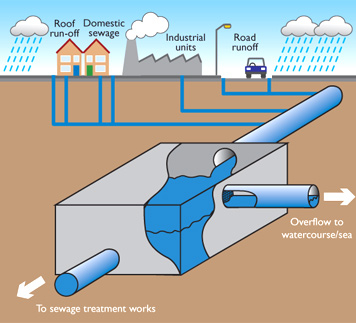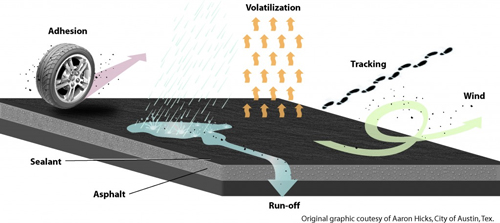When it rains and snow melts, water runs off the land into our state’s lakes, rivers, streams and wetlands. Stormwater runoff from urban and rural lands carries pollutants with it into our waterways. Runoff from farmland can contain nutrients and pesticides. Urban runoff can also wash nutrients, road salt and other pollutants from paved areas, such as coal tar sealants, into our waterways.
Urban Stormwater
Impervious surfaces are structures such as roofs, parking lots, driveways and streets that prevent water from soaking into the ground, increasing the amount of surface runoff from rain and snowmelt. The introduction of as little as 10-20% impervious cover can double the amount of surface runoff as compared to areas with natural cover.Without the filtration process that the natural ground provides, this runoff collects pollutants and carries them to sewer systems and, ultimately, lakes and streams.
 In natural areas with pervious surfaces, rainfall and snowmelt soaks into the ground and is absorbed by the soil, eventually entering groundwater or nearby bodies of water. When large storm events occur in areas with a high amount of impervious surface, infiltration is not possible and the water remains above ground, causing flooding to occur. This is especially dangerous in areas with a combined sewer system, which carries both sewer and stormwater in a single pipe system. When the volume of runoff exceeds the capacity of the sewer system or treatment plant, the excess untreated wastewater is discharged into nearby water bodies. These combined sewer overflows (CSOs) pose a threat to human and ecological health.
In natural areas with pervious surfaces, rainfall and snowmelt soaks into the ground and is absorbed by the soil, eventually entering groundwater or nearby bodies of water. When large storm events occur in areas with a high amount of impervious surface, infiltration is not possible and the water remains above ground, causing flooding to occur. This is especially dangerous in areas with a combined sewer system, which carries both sewer and stormwater in a single pipe system. When the volume of runoff exceeds the capacity of the sewer system or treatment plant, the excess untreated wastewater is discharged into nearby water bodies. These combined sewer overflows (CSOs) pose a threat to human and ecological health.
There are many stormwater best management practices (BMPs) that can be incorporated into existing development in urban areas, blending in with infrastructure or acting as the infrastructure themselves. Stormwater BMPs prevent, intercept, and/or treat stormwater near the source, allowing them to be customized to meet the stormwater management objectives of a specific site. By decreasing the amount of stormwater runoff, they reduce the infrastructure requirements of centralized facilities and help to prevent CSOs and flooding. They also provide various water quality benefits, filtering out pollutants before runoff ever reaches the sewer system and reducing reliance on treatment plants to treat the water before discharging it. Examples of stormwater BMPs suitable for urban lands include green roofs, pervious pavement, downspout disconnection, rain gardens and buffer/filter strips.
Coal Tar Pavement Sealants
Stormwater runoff transports many pollutants, some of which are of special concern and are priority targets for Sierra Club efforts. One of these priority pollutants is coal tar sealant, a harmful product that is used commercially and by homeowners across the United States. Sierra Club is working hard to get communities throughout Illinois to eliminate the use of coal tar sealant in order to protect human and environmental health.
What are coal tar sealants?
Coal-tar-based sealant (also called sealcoat) is a black, viscous liquid that is applied to asphalt pavement of driveways, parking lots, some roads and even some playgrounds. It is meant to protect and beautify the pavement, but its effects make it a major concern for human and environmental health.
Why are coal tar sealants a problem?
Most sealant products used in the central, southern and eastern United States have a coal-tar-pitch base. This type of sealant contains extremely high levels of polycyclic aromatic hydrocarbons (PAHs), several of which are suspected human carcinogens and are toxic to aquatic life. Coal tar sealants contain about 1,000 times more PAHs than the safer alternative, asphalt-based sealant products, which are used mostly in the western United States. PAHs in coal tar sealant are carried to waterways and human-inhabited spaces, causing harm to aquatic life and posing health risks to humans.
How do coal tar sealants get into our waters, soil and homes?
 When vehicles drive over pavement sealant, the friction from their tires abrades the sealant into small particles. These particles are carried by rain and snowmelt down storm drains and into rivers and streams. The particles can also be blown into the soil by wind, evaporated into the air, or carried into homes on the soles of shoes.
When vehicles drive over pavement sealant, the friction from their tires abrades the sealant into small particles. These particles are carried by rain and snowmelt down storm drains and into rivers and streams. The particles can also be blown into the soil by wind, evaporated into the air, or carried into homes on the soles of shoes.
Humans can be exposed to PAHs in sealants through ingestion of abraded particles or through skin contact. When sealant particles are tracked indoors, the PAHs in the particles become incorporated into house dust. This can be dangerous for anyone, but especially for infants and young children who spend a lot of time on the floor, touching toys and putting them in their mouths.
What are the effects of PAHs on humans and aquatic life?
Studies conducted by the U.S. Geological Survey have found there to be “a significant increase in estimated lifetime cancer risk for residents living near coal-tar-sealcoated pavement associated with incidental ingestion of PAH-contaminated soil and house dust.” [1] Although seven PAHs are probable human carcinogens, there are currently no U.S. health-based guidelines for exposure to PAHs. One German guideline for a single PAH was exceeded in four of the eleven apartments with coal tar sealant parking lots examined by a U.S. Geological Survey study.
Several PAHs are toxic to mammals (including humans), birds, fish, amphibians, invertebrates and plants. The observed effects on aquatic health include stunted growth, liver problems and mortality in amphibians exposed to sediment contaminated with coal tar sealant. Recent studies have shown impairment in aquatic communities living downstream from stormwater runoff from sealcoated parking lots. Insects and other small creatures living in sediment of streambeds are especially vulnerable, as this is where PAHs tend to accumulate. These animals play an important role in the food chain and overall ecosystem balance, and are often monitored as indicators of stream quality.
How can you help?
Banning coal tar sealants does not mean banning sealants altogether. The safer alternative, asphalt-based sealant, is most frequently used in western U.S. cities where concentrations of PAHs in sealant dust are significantly lower. Several jurisdictions have already banned the use of coal tar sealants, including Austin, Texas, Washington, D.C., and several communities in Wisconsin and Minnesota. We are currently working with Illinois communities to get them to ban the use and sale of coal tar sealants. Advocating for this ban in your community and your state, as well as educating others on the danger of this product, will help us in our efforts to make Illinois communities safer and our waterways healthier.
The Minnesota Pollution Control Agency offers tips for choosing the right type of sealant for your home. They also provide information on what bans are in place and which companies have committed to only use the less toxic asphalt-based sealant alternative.
References and Resources
· Additional USGS Research on PAHs and coal tar sealant: http://tx.usgs.gov/coring/allthingssealcoat.html
Images from:
- wessexwater.co.uk
- U.S. Geological Survey